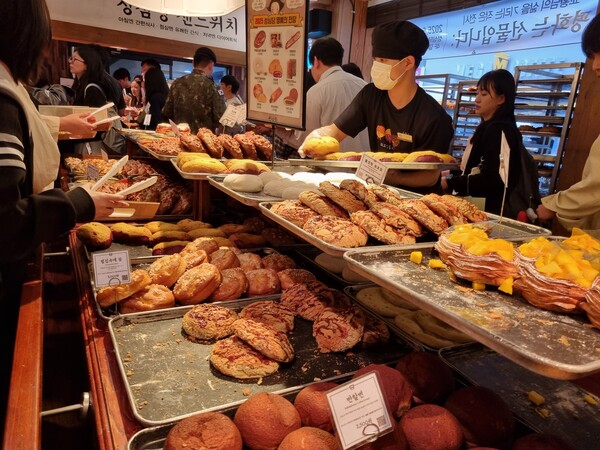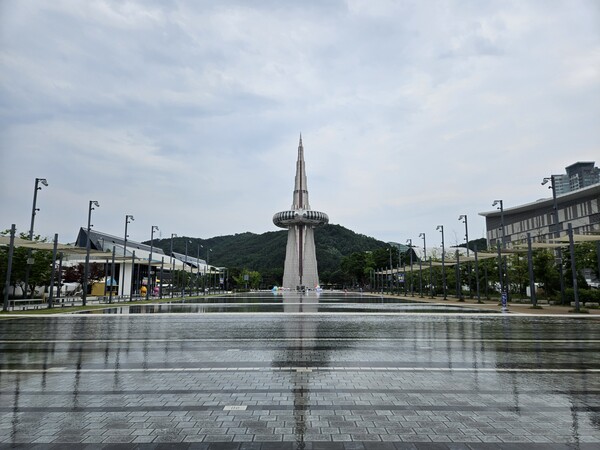During this year’s golden holiday period, which included Children’s Day, Buddha’s Birthday, and an alternative holiday, many people took advantage of the warm spring weather to travel. While overseas travel gained popularity, local regions like Gangwon State and Jeju Island still attracted large numbers of visitors, maintaining their status as leading domestic destinations. Meanwhile, a new city is rising as a popular tourist hotspot, Daejeon. Once labeled a “boring city,” Daejeon is now shedding that outdated image and transforming into an exciting travel destination. Weekend KTX train tickets often sell out in advance due to high demand, indicating this is not just a passing trend. Among Daejeon’s iconic landmarks is Sungsimdang, a local bakery that sparked a nationwide “bakery pilgrimage” trend. While it remains a must-visit, Daejeon is now attracting visitors with much more than just Sungsimdang. Daejeon’s unique cultural identity and new content offerings are captivating travelers. In addition, Daejeon is making strides as a science city, with growing investment in research hubs. This article explores how Daejeon has overcome its reputation as a dull city and is rising as an attractive tourist destination.

Daejeon, city of flour
Sungsimdang is not only Daejeon’s most famous spot, but also widely recognized as Korea’s number one bakery. True to its name, “Sacred Heart Hall,” Sungsimdang was founded by a devout Catholic entrepreneur. Its beginnings trace back to post-war Daejeon when the founder received sacks of flour from a Catholic priest. He began selling steamed buns made from that flour, and thus, Sungsimdang was born. From the outset, the bakery upheld strict quality standards and reasonable prices. Sungsimdang survived and thrived through regional marketing and the development of unique, signature products. Its famous bread, such as “fried soboro bread,” became a symbol of the brand. The bakery’s fame surged in 2014 when the late Pope Francis, during his visit to Korea, reportedly had Sungsimdang bread for breakfast. Since then, it has become a must-visit destination for tourists. Sungsimdang now operates a variety of locations across the city, each offering slightly different product selections. Long lines are a common sight at all branches, with separate queues for bread, cakes, and sometimes even sandwiches depending on the store. In 2023, Sungsimdang recorded a staggering annual revenue of 123.4 billion won. A new “Sungsimdang Street” has formed around its main branch, which now features a cafe and bakery experience zone in addition to the original store. Tourists can even explore the Sungsimdang History Hall, where over 70 years of the bakery’s legacy and Daejeon’s historical changes are showcased. To the local community, Sungsimdang represents not just bread, but home, memory, and pride. The phrase “When in Daejeon, go to Sungsimdang” has become a kind of slogan, and the bakery plays a crucial role in elevating Daejeon’s brand value.
Beyond Sungsimdang, Daejeon is also famous for flour-based dishes such as kalguksu, which means knife-cut noodles. Its nickname as the “City of Flour” or “Flour Capital” has historical roots. As a key transportation hub, Daejeon Station once served as a major storage and transfer point for flour. During the Japanese colonial period, Daejeon occupied a strategic location where the Gyeongbu Railway Line, which connects Seoul and Busan, intersected with the Honam Railway Line, which runs between Daejeon and Mokpo. This made Daejeon a central hub for logistics and the movement of goods. Agricultural and marine products from various regions across the country were gathered in the city. This transportation advantage also made Daejeon a key base for resource extraction.

After the Korean War, flour provided as foreign aid was distributed nationwide through Daejeon. The abundance of flour led to the development of various flour-based dishes. In the 1960s and 1970s, workers participating in West Coast land reclamation projects received flour donated by the United States as compensation, further reinforcing Daejeon’s role in the country’s flour trade and food culture. Today, this history is reflected in the city’s culinary scene. With the recent surge in tourism, it is common to see long lines forming at popular kalguksu and sujebi restaurants on weekends. Some restaurants even draw lines before opening hours, as both locals and visitors flock to taste these signature dishes. However, thanks to fast turnover rates and efficient service, diners usually do not have to wait long to enjoy a warm, satisfying meal.
Events such as the “Daejeon Kalguksu Festival,” “Noodle Daejeon Festival,” and “Daejeon Bread Festival” celebrate this unique culinary heritage, attracting food lovers from across the country. These festivals not only showcase local flavors but also highlight the creativity of a new generation of chefs.
Daejeon’s flour story is more than a food tale it is a living legacy of modern Korean history, local economy, and cultural evolution. From a vital logistics hub to a culinary capital, the city’s journey is kneaded into every bite of warm noodles shared at a crowded table. For many, enjoying a bowl of kalguksu in Daejeon is more than just a meal it is a way to taste history, community, and identity.

Daejeon’s emergence as a multifaceted tourist city
The success of Sungsimdang brought an influx of visitors, prompting the Daejeon city government to invest more actively in tourism infrastructure. As a result, the city now offers many unique attractions, presenting a vibrant alternative to Seoul’s urban landscape. One of them is Daedong Mural Village, known for its colorful wall art and narrow alleyways. These winding paths have been transformed into popular photo spots for Instagram. Another highlight is the Soje-dong Historic Residence Area, where former colonial-era railway officials’ homes have been converted into nostalgic cafes and art spaces. Tourists can also enjoy local flavors and traditions at the Daejeon Station Central Market, take in expansive views from Daedong Sky Park, immerse themselves in nature at Hanbat Arboretum, or rest at Yuseong Hot Springs Park with a relaxing soak and stroll.
The newly built Eagles Park has also been drawing significant attention, as it serves as the proud home of the Hanwha Eagles and their famously passionate fanbase, considered one of the most enthusiastic in Korea. After years at the bottom of the rankings, the team’s strong performance in the 2025 season has electrified the league, with tickets selling out instantly and fans from across the country visiting Daejeon to join in the excitement. This baseball fever has also revitalized the local economy, filling restaurants, shops, and accommodations throughout the city on game days.
In parallel, Daejeon is fostering cultural startups, particularly in its older downtown districts. The Daejeon Cultural Startup Center provides office space and seed funding to young entrepreneurs in tourism, arts, and performance, aiming to generate original content that reflects the city’s unique character. In addition, to improve travel convenience, the city government is accelerating the construction of a light rail tram system, scheduled for completion by 2027. This eco-friendly transportation network will connect major tourist spots and significantly enhance accessibility for visitors. Looking ahead, the city plans to unveil more signature attractions through the “Daejeon Landmark Project” by 2026.
What began with the popularity of one beloved bakery has blossomed into a cultural movement filled with local heritage, nostalgic charm, sports enthusiasm, and creative innovation, positioning Daejeon as one of Korea’s most promising emerging travel destinations.
Daejeon has worked steadily to shed its reputation as a “boring city,” and has successfully transformed into a destination where culture and tourism harmonize. In a society still heavily focused on international travel, Daejeon’s example provides a positive case for revitalizing domestic tourism, and may inspire other local governments. From Seoul, Daejeon is only a short KTX or express bus ride away, making it a perfect weekend getaway. If you plan to take the KTX, it is a good idea to book your tickets in advance. Whether it is the iconic bread of Sungsimdang, the charming alleys of Daedong Mural Village, the retro vibes of Soje-dong, the thrilling baseball games, or the delicious flour-based dishes found throughout the city, Daejeon now offers far too much to explore in just one day. As you return home, arms full of bread, this has become a familiar sight at Daejeon Station, a symbol of how far the city has come. With new infrastructure like the tram and ongoing cultural investment, Daejeon’s appeal is expected to grow even more. Once just a stop on the way to somewhere else, Daejeon has now become the destination itself. Is Daejeon still a “boring city?” Or has it become one of Korea’s exciting up-and-coming travel spots? Why not see for yourself this weekend?
- [471 Culture] How MBTI Became a Cultural Code
- [471 Special Edition] The Sneaker Tech Craze Among Youth
- [471 Clip] Celebrating the Legacy of Shin Kyung-rim
- [471 Cover] Institutional Dilemmas in Managing Growth: Challenges of Internationlization in Universities
- [471 Editorial] Not a Long Farewell, Just a Quiet Intermission
- [471 International's Eye] Democracy and Dialogue Across Cultures
- [471 Reporter's Eye] Possibility of a New Beginning
- [471 K-Trend] A Culinary Makeover Brings Innovative New Flavor to Convenience Stores
- [471 Cartoon]
- [471 Round-up] Dongguk Literature Reaffirmed as Students and Alumni Win Major Literary Prizes
- [471 Campus] Letting Go Leads to True Nirvana at Dongguk’s Spring Festival

